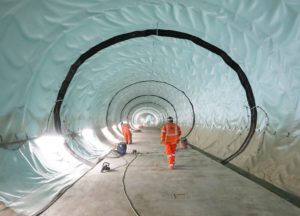Transport for London has set out its plan to deliver vital improvements despite reduced Government funding and uncertain economic climate.
Publishing its Business Plan for 2018/9 to 2023/4, TfL has set out its ambition of delivering a modernised transport network together with efficiency savings, making London’s roads safer and healthier and supporting new homes, jobs and growth.
Despite an average £700M per year reduction in government funding, the subdued economy and the impact from Crossrail delay, TfL is continuing investment in modernising the network and has made major progress on efficiency savings, which are ahead of target.

Bank Station Upgrade works
The Business Plan fully aligns with the Mayor’s Transport Strategy and outlines how TfL will continue to invest in the vital transport improvements London needs,
The recent announcement by Crossrail Ltd that there will be a delay to the opening of the Elizabeth line has also meant that TfL needs to pay for the additional capital investment to fund the completion of the line and also absorb the impact of lost fare revenue. The Mayor of London and Government has agreed a financial package to cover the additional capital investment required to complete the Crossrail project, which will be repaid via London’s Business Rate Supplement (BRS) and from the Mayoral Community Infrastructure Levy (MCIL).
Across the five year plan, TfL will invest in vital improvements including:
- Completion of the signalling upgrade on the Circle, District, Hammersmith & City and Metropolitan lines, which will add 33% capacity across the four lines by the end of 2023. TfL will also begin the modernisation of the deep Tube lines, beginning with the introduction of new longer, more spacious and comfortable walkthrough trains on the Piccadilly line from 2024.
- Continuing to progress major station upgrades to the Tube network, such as at Elephant & Castle and Holborn stations, completing work at Bank station, as well as opening the Northern Line extension to Battersea, which will support 25,000 jobs and 20,000 new homes.
- Making more stations fully accessible across London, including Finsbury Park, Hanger Lane and Wimbledon Park – meaning that more than a third of the Tube network will be step-free by 2020
- Investing £2.3Bn on transformative projects to make London’s streets safer, better places for everyone. Junctions like Old Street, Vauxhall Gyratory and Highbury Corner will be made safer for all road users and new Liveable Neighbourhoods will be created in local areas across outer London, helping cut polluting car use and encouraging walking and cycling. New high-quality cycle routes in Greenwich, Hackney and Hounslow will also be accelerated to connect communities and help Londoners to live active, healthier lives.
- Sustained investment for key transport improvements across London’s boroughs to help them deliver the Mayor’s Transport Strategy, including actions to reduce traffic, boost safety and increase active travel in their local areas.
- Continuing to make vital radical air quality and environmental improvements across London,
- Introducing fleets of new trains on the London Overground and Docklands Light Railway (DLR). From next year, construction will also begin on building an extension of the London Overground to Barking Riverside, which will support 10,800 new homes being created on one of Europe’s largest brownfield sites.
- Continuing to develop plans to build Crossrail 2 and extend the Bakerloo line, the DLR and tram networks in the next 20 years, which will support the creation of thousands of new homes and jobs across London and the south east.
- Bringing into service the Elizabeth line, which will transform journeys across London and out to Reading and Shenfield, with quicker and easier journeys and mark a step-change in accessibility with 41 step-free stations.
- Unlocking land for the development of new homes and actively making smarter use of TfL assets – including improved retail units and innovative digital advertising – to generate greater long-term revenue.
The Mayor of London, Sadiq Khan, said: “We are pushing ahead with our ambitious plans to make London a cleaner, safer, healthier city with more affordable and accessible public transport. This is despite an average reduction of £700M per year in TfL’s funding from Government, and the financial challenges of uncertainty in the economy and the delay to the Crossrail project.
“Through our work to make TfL more efficient, including reducing its costs by £500m per year, we are continuing to transform the Tube network and taking radical action to clean up our toxic air. I’m proud that TfL fares will be frozen once again from next January, continuing to make transport more affordable for millions of Londoners.”
TfL’s Business Plan will be considered by its Finance Committee and can be viewed here.
If you are interested in finding out more about key infrastructure trends today, you may wish to attend the flagship infrastructure exhibition at the NEC in April 2019 : UKIS 2019
Click here for more information on how to register or exhibit at the UK Infrastructure Show 2019.
If you would like to read more articles like this then please click here.
The post TfL publishes Draft Business Plan appeared first on UK Construction Online.
Walang komento:
Mag-post ng isang Komento